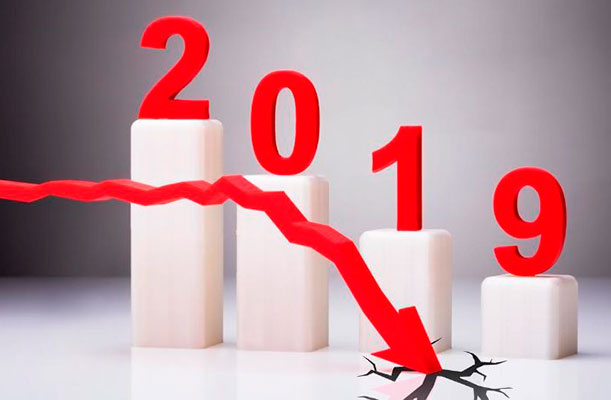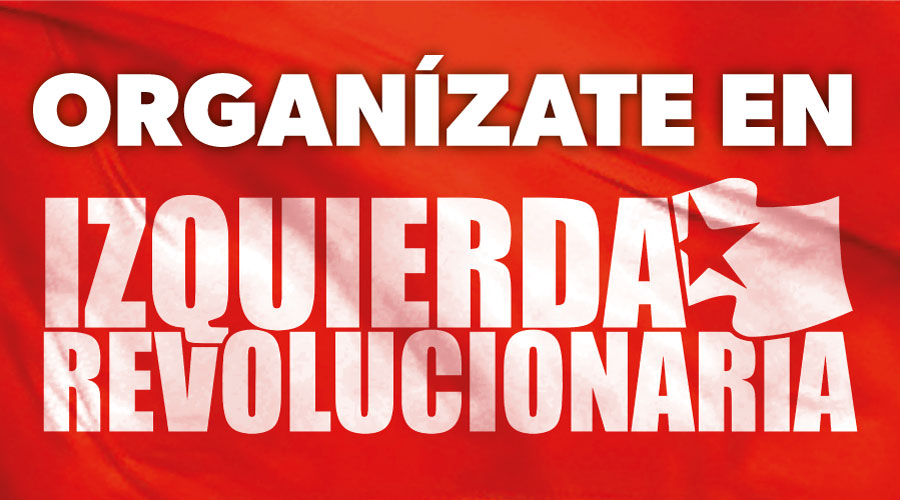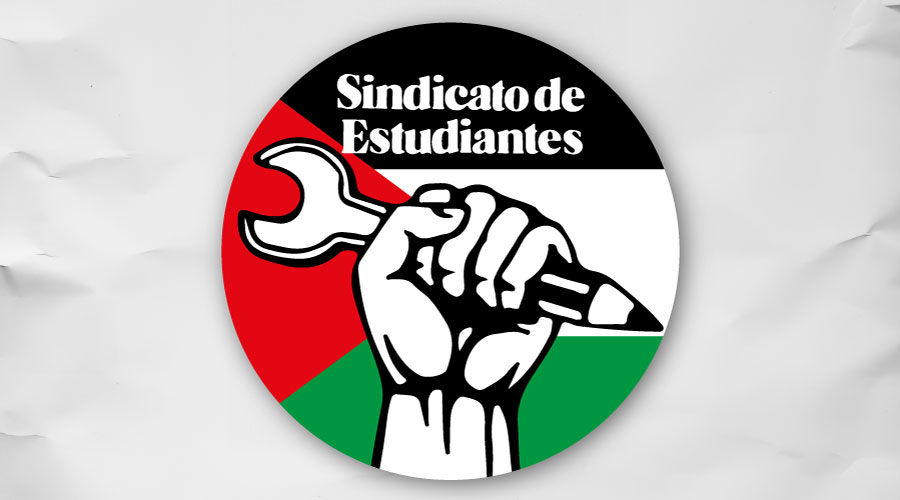“Modern bourgeois society, with its relations of production, of exchange and of property, a society that has conjured up such gigantic means of production and of exchange, is like the sorcerer who is no longer able to control the powers of the nether world whom he has called up by his spells. For many a decade past the history of industry and commerce is but the history of the revolt of modern productive forces against modern conditions of production, against the property relations that are the conditions for the existence of the bourgeois and of its rule.”
Marx-F. Engels, The Communist Manifesto
The capitalist system is completely disrupted. The precipitation of the economy towards a harsh recession — trumpeted by the global financial institutions and their media spokespersons — is only one of the factors in the situation. On must go back to the most turbulent times of the 20th century, specifically to the thirties and seventies, to see how political events intertwine with the economic events generating a climate of uncertainty and pessimism in large sections of the ruling class all around the world.
The negative elements of this dynamic extend fo all planes:
- The upsurge in inter-imperialist struggle for the control of markets, areas of influence and raw materials is being felt with great intensity. International relations have been badly shaken: old alliances between the great powers and their vassal states are breaking down while new ones are established, producing long military conflicts and the balkanisation of the globe.
- The struggle for political supremacy between the US and China has its own dynamic, accelerating the trade war with pernicious consequences. The competitive devaluation of currencies — the yuan reaching all-time lows and Trump urging the Federal Reserve for a drastic drop in rates — worsen the trend, while world trade continues to contract.
- The Brexit means the most important failure of the UE and places a large question mark over its future. The European block is plunging further in its subordinate position, suffering a decline of its exports in the global market. Both Germany — the dominant power in the old continent — and Great Britain are already suffering the symptoms of the recessionary cycle (their respective GDPs fell by 0.1% and 0.2% in the second quarter of the year). Italy, with two falls, two periods of stagnation and just a slight rise in five months, is also facing a political crisis with unpredictable results.
- The economic and social decomposition of capitalism in Latin America announces a cycle of labour and social struggles that will put new revolutionary crisis on the agenda.
- The decadence of parliamentary democracy and the Bonapartist and authoritarian tendencies of many western governments — the most recent example is Boris Johnson in Great Britain — show the collapse of the stability and internal equilibrium of the capitalist system, also characterised by a profound división of the ruling class country after country. The profound social and political polarization, the split of the middle classes to the right and left, and the delegitimization of the Social Democracy and the traditional conservative parties are the result of the growth of inequality after years of social cuts and austerity.
- Although the nationalist reaction knows today a greater power than in previous decades (Trump, Bolsonaro, Salvini… are clear examples), to just consider this aspect of reality would be an evidence of political blindness. The historical process shows many contradictory elements and deep processes in the consciousness of the masses develop under the envelope of these governments. The conservative traditions that the democratic state imbued for decades are turning into a questioning of capitalism among large sections of the working class and the youth that turn to the Left. The huge mobilizations of working women for their rights or the strikes of the youth against climate change are only the tip of the iceberg of the rise and radicalization of class struggle all over the world.
Financial speculation and debt. The lessons of the past have not been learned
It cannot be denied that capitalism has had a great historical merit in raising the technique and productivity of labour to the highest level, and establishing a global economy and the objective conditions for the great resources of the planet to be used in a rational and harmonious manner. But 21st century capitalism is not only further than ever from accomplishing this task, but the overabundance of capital and commodities as well as the advancement of technology have become, under the domain of private property and the nation state, a leading cause of a stunning shortage and poverty, mass and structural unemployment, and an extreme job insecurity.
The capitalist agenda deployed to stave off the Great Recession of 2008 has been unable to respond to the challenge and has worsen all the structural contradictions that came to the fore a decade ago. In no way did the world bourgeoisie intend this outcome, which has been imposed against its will and its intentions: the productive forces have exceeded its control pushing society towards either ruin or revolution.
The global stagnation has also been manifested itself in world trade. It must be remembered that in the nineties and at the beginning of the new century, major political factors such as the collapse of the Stalinism in the USSR, Eastern Europe and China encouraged the opening of new markets and production branches promoting a new international division of labour. The expansion of trade was a key factor for European and US capitalism, along with China, to achieve two decades of sustained growth, dotted with brief recessions (from 1987 to 2007 approximately). The average share of exports and imports in world GDP increased from 20% in 1995 to 30% in 2014 and, in the same period, global exports of commodities increased four-fold.
The withdrawal of international trade is now a fact: after growing at an average rate of 7% a decade ago, it will grow a ridiculous 2.6% in 2019 (in the first quarter of the year, global exports experienced an interannual decrease of 2.7% and imports fell by 3.1%).
Private investment, a key factor for the reanimation of the economic cycle, is also undergoing a sharp decline. According to OECD data published last April, foreign direct investment (FDI) in the World contracted by 27% in 2018 and by 16% in 2017.
After the outbreak of 2008, the G7 (or G8 while Russia took part) and G20 Summits used to close with great declarations in favour of a strong regulation of investment banks and public controls to avoid a new speculative bubble. But this propaganda could not disguise what governments worldwide were really doing: indiscriminately injecting liquidity to save the big banks, financial corporations and heavily indebted companies with large solvency problems, plundering public resources through savage plans of social cuts and massive privatizations.
This is the reason for unprecedented financial benefits, which has exposed the parasitic nature of this kind of capital, increasingly fictitious and divorced from the real economy, which obtains capital gains not from productive investment and sale of commodities but from its propagation in stock markets through speculative financial products. At present, US banks own $157 trillions in financial derivatives, in other words, twice the world GDP and 12% more than in 2008. (1)
Along with the great speculative bubble that is advancing in leaps and bounds, global debt, both public and private, has broken all records hampering the recovery and setting the stage for an even more dramatic relapse. According to the Institute of International Finance (IIF), at the end of 2018, household, corporate, bank and government debt all around the world amounted to $243.2 trillion, equivalent to 317% of global GDP.
Recessional tendencies are highlighted by two other phenomena: the sovereign debt of many countries at negative interest rates (as in the case of Germany) has increased by 50% in the last three months, to $15 trillion. Such an exceptional situation has led ex-Fed chairman Alan Greenspan to state: “definitely something is out of control. Central banks have pumped so much liquidity in the market that risk and value have very little meaning.”
The other factor is the excess return of the two-year US bond, presently higher than that of the 10-year bond. In other words, major investors are doubtful about what might occur to the US economy in the medium term, despite its brilliant growth figures and little unemployment.
Struggle for hegemony
The US-China trade war represents a qualitative transformation in international relations within a much broader struggle for world supremacy. Although the US continues to maintain the leading position in many respects, it cannot hide its great difficulties in coping with the strength of Chinese imperialism.
Some data can serve as an example. Between 2000 and 2015, China went from producing 3% of the world's steel to totaling 50%, and only between 2011 and 2013 it consumed more cement than the United States in the entire 20th century (International Cement Review).
In 1980 Chinese exports represented only 1% of the world total, but in 2018 it has positioned itself as the world's main exporting power with about 12.8%, followed by the US (8.5%) and Germany (8%). The US trade deficit with China exceeded $420 billion in 2018. China accounts for 30% of global car sales, 43% of electric vehicles and 42% of retail sales of commercial transactions (these and other data from China and the world: Inside a changing economic relationship, report by McKinsey Global Institute). China also leads electronic commerce: 50 billion parcels were shipped within the country's borders in 2018, and 71 billion are expected to be shipped next year. Consultancy firm eMarketer predicts that in 2020 electronic commerce in China will reach $2.5 trillion, almost one trillion more than the rest of the world put together.
China captured about 10% of the world's foreign direct investment (FDI) in 2017, compared to just 1% in 2000, and was responsible for more than a third of global growth in the last ten years. It has also become the US banker controlling 18.7% of the US debt, $1.18 trillion.
China is battling the US for the global markets in numerous areas, and thanks to its large trade surplus and its gigantic foreign exchange reserves is investing billions of dollars to gain control over the production of strategic raw materials.
But Chinese state capitalism also accuses overproduction and, despite all state stimulus plans, its GDP only grew 6.6% in 2018, the lowest level since 1990. This is the objective reason why the Beijing regime cannot give in. Through the “One Belt One Road” megaproject they are carrying out an aggressive policy of international agreements entailing millions of dollars of infrastructure investments, disputing the control and future leadership of world trade.
The US bourgeoisie is at an historic crossroads. Figures published in business journals about its record of 121 months of uninterrupted growth, and an official unemployment rate of 3.6% ― the lowest figure recorded in fifty years ― cannot hide the decline of the great world power. The average GDP growth in the Trump era, of 2.3%, is the lowest in 70 years.
US industrial production has been receding since 1970, when it accounted for 25% of the GDP, up to around 11% now. The same applies to capital expenditures and replacement of equipment: at the end of the nineties represented around 50% of total investments and today is under 30%. The responsibility for this lies not on Beijing but on the US ruling class, who promoted industrial relocation towards China and other countries with low wages and and slavery working conditions.
Trump's economic measures have only exacerbated social pauperization, increasing the chronic inequality that dragged under the Obama administration.. His tax cut, announced to help the middle class, has only enriched the very rich. Billionaires went up from 267 in 2008 to 607 in 2018, while 39 million people get federal aid for food.
The average family income has grown by 8% between 2009 and 2017, but this fact hides that one fifth of those sectors of the population with less income have just captured 0,2%. Gini coefficient, which measures inequality in terms of income distribution, is now at its pick in the US: 0.48% as opposed to 0.38% in the late 1960s, that is, a 30% increase.
The American middle class, the traditional bulwark of reaction and republican conservatism, is being wiped out. According to the Fed’s consumer survey, one-third of middle income adults say they would borrow money, sell something or not be able to pay an unexpected $400 expense. One fourth said they skipped some kind of medical care in 2018 because of its cost. Nearly three in 10 middle-income adults carry a negative balance on their credit cards most of the time. Meanwhile, the share of income spent on rent by middle class renters rose to 25% in 2018 from 18% in 2007, a rise of 40%. This explains the oscillations to the left and to the right of these sectors and the volatility of the support for Trump.
Economic nationalism and trade war
The global economic crisis triggered after the 1929 Crash ― which is impossible to analyze in this article ― was reinforced by the widespread adoption of protectionist measures and competitive devaluations between the different powers in order to “protect their markets”. As a result, between 1929 and 1935, world trade fell over 30% and GDP in the US and in the main European nations contracted by over 14%.
The explosión of economic nationalism was not the exclusive work of Hitler or Mussolini, but of all the capitalist powers, both fascist and “democratic”. The current renaissance of economic nationalism and right-wing populism, adopted as a flag by a broad sector of the capitalist class in many countries, is not explained by subjective factors derived from the charisma of certain individuals, but as an objective tendency of the processes that take place in the economy and world politics.
When Donald Trump arrived at the G7 meeting in Biarritz by the end of August, all his wrath was unleashed on the media: “the vast amounts of money made and stolen by China from the United States, year after year, for decades, will and must STOP.” “We don’t need China and, frankly, would be far better off without them.” These and similar messages filled newspaper headlines.
Did Trump really believe that the Beijing regime was going to sit idly by without responding to his measures? Of course he didn't believe it, and his bravado is a confession of impotence of US imperialism.
Finally, on Sunday, September 1, additional tariffs of 15% came into force on a portion of the $300 billion in imported Chinese goods that had not been penalized so far. China responded with levies between 5 and 10% on US products valued at $75 billion (over EUR 68.2 billion).
These decisions will increase production costs in the US, but also in China and Europe. They will severely affect the automobile sector in the United States, which in 2018 sold vehicles with a total value of $250 billion in China. But they will also affect oil, soya (China is the biggest importer of American soya), nuts, pork, frozen fish and seafood, beef… The Asian giant is the fourth largest agricultural export market for the United States ($9.3 billion in 2018).
Nor must we forget that nearly 77% of the exports US receives from the Asian country are semi-fabricated products used to produce goods in US industries. Trump’s protectionist policy will not provide a solution. On the contrary, the situation will get much worse.
But China will also lose with the trade war. Between 2011 and 2016, its technology purchases in the global market were shared between three of its direct rivals: 27% came from the United States, 17% from Japan and 11% from Germany. China produces 75% of the world’s smartphones and 90% of the computers and the blocking of international markets, as is the case with Huawei, of which we have spoken in other articles (2), could have extremely negative consequences.
At present, foreign companies produce 87% of Chinese electronics and 60% of machinery, and the total number of foreign companies operating in China increased from 203.000 in 2000 to 481.000 in 2015, when they employed nearly 14 million workers. Almost 40% of China's exports are produced in factories with foreign or mixed capital.
The Eurozone will not be able to avoid the harsh effects of this war. Currently, it is the block with the largest current account surplus, $465 billion in 2018. But this surplus has gone down by 21% since January, directly affecting the German economy (whose import sector provides 50% of its GDP), France and Italy.
Socialism or Barbarism
All the previous data show that capitalist production has become completely social, has created an international division of labour and a world market from which no national economy can decouple. Autarchy and economic nationalism constitute a reactionary dream, as was proven in the thirties of the last century, and behind its screen hides the most aggressive of imperialisms.
Those most responsible for world politics, paraphrasing Trotsky, look like children running around the slope of a volcano before an eruption. The recession seems imminent, but the great capitalist powers divided more than ever, do not calculate the effects of a new crisis on the consciousness of the masses. Years of deprivation and impoverishment have generated a collective rage that continues to grow. The ruling class will not be able to resort to policies that have already shown their exhaustion in the face of a new explosion of unemployment, business closures and economic decomposition.
We are heading for a fundamental clash between the classes. Yes, reality completely revindicates the Marxist programme included in works such as Capital or the Theory of surplus value, written over 150 years ago. But the working class will not reach these conclusions just by reading but through its experience.
Socialism will not fall from the sky like a ripe fruit, but as a result of the conscious intervention of the working class and the youth in action. Only the socialization of the means of production can resolve the economic collapse and the barbarity happening before our very eyes. The world productive forces need a new social system that plans and organizes them in a harmonious and democratic way. Through mistakes and defeats, the workers leading the oppressed of the world will draw the appropriate political and practical conclusions, forge the revolutionary party able to successfully complete the task and expropriators will definitely be expropriated. Socialism will win, humanity will win.
NOTES:
(1) “The big banks that were rescued by the US government in 2008 because they were seen as too big to fail have become even more too big to fail, with the ‘Big Six’ US banks – JP Morgan Chase, Citigroup, Wells Fargo, Bank of America, Goldman Sachs, and Morgan Stanley – collectively having 43 per cent more deposits, 84 per cent more assets, and triple the amount of cash they held before the 2008 crisis. Essentially, they had doubled the risk that felled the banking system in 2008.” Walden Bello, Global Finance, power and Instability capitalism prepares recession 2.9, 19 June 2019.
http://longreads.tni.org/state-of-power-2019/global-finance/
(2) Nacionalismo económico y guerra comercial. El capitalismo ante el abismo, Bárbara Areal, junio 2019. https://www.izquierdarevolucionaria.net/index.php/economia/11563-nacionalismo-economico-y-guerra-comercial-el-capitalismo-ante-el-abismo





















































